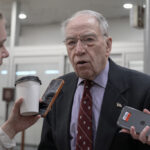
–>
March 20, 2023
I have argued on these pages that the Epstein scandal was a harbinger, and that the normalization of adult-child sexual relations was already in full swing. Nowhere does this seem to be more evident than in our public schools.
‘); googletag.cmd.push(function () { googletag.display(‘div-gpt-ad-1609268089992-0’); }); }
This past month, Californian elementary school teacher and recently awarded “Teacher of the Year” Jacqueline Ma was arrested and charged with, among other things, three counts of “oral copulation” with a 13-year-old student. I wish this were an aberration, but all the evidence points to the opposite.
In 2004, a Department of Education report estimated that approximately 10% of public school students will experience sexual misconduct (often unreported) at the hands of an educator by the time they finish high school. If that percentage has remained steady to today (it has in all likelihood increased), that means that approximately 4.9 million public school students have been sexually abused by their teachers.
From the 2015–16 to the 2017–18 school years, Department of Education data show a 55% increase in sexual assault in schools to nearly 15,000 annual (reported) incidents. In 2022, nearly 350 public educators (grades K–12) were arrested for child sex crimes. That averages to one a day (that we’re aware of), and, as this timeline includes summer breaks, holidays, and weekends, the average is probably higher.
‘); googletag.cmd.push(function () { googletag.display(‘div-gpt-ad-1609270365559-0’); }); }
In Chicago alone, the inspector general has substantiated more than 70 sexual misconduct allegations out of a total of more than 600 complaints in the 2021–2022 school year. Since 2018, the same office said that policy violations were found in over 300 investigations. This is out of a total of only 40,000 employees.
There are laws prohibiting “passing the trash” (i.e., quietly shuffling a known abuser from one school district to another), but application of these laws varies from state to state, with some performing more lenient background checks than others. USA Today could find only a single instance of school administrators facing criminal penalties for such negligence (and the penalty was a $2,000 fine, community service, and 18 months’ supervision). This trend is verified by a 2010 GAO study. Yet teachers’ organizations continue to resist national databases, which could better track sexual predators posing as teachers.
Two decades ago, the Catholic Church was called out for tolerating and covering up sexual abuse of children by pedophile priests, who likewise were quietly shuffled from parish to parish rather than fired and prosecuted. The national outcry was deafening. Investigations were launched. Movies were made. Heads rolled. And rightfully so.
But the rate of sexual abuse by priests doesn’t exceed the rate of sexual abuse by American males in general. In other words, our kids are in no more danger of being molested by a priest than they are by, let’s say, a plumber or an accountant. What shocked our collective conscience, beyond the crimes themselves, is that they were covered up by institutions in which the public places its trust to protect our children.
Nowadays, we have an identical scandal in our public schools, the only difference being that teachers are 100 times more likely to sexually abuse children as are priests. The numbers speak for themselves. Approximately 0.1% of Catholics reported sexual abuse by a priest compared to the nearly 10% of public school children who have reported sexual abuse by an educator.
Or for a more topical comparison, from 2005 to 2019, there have been 104 law enforcement officers arrested for murder or manslaughter resulting from an on-duty shooting. Of those, only 35 have been convicted. According to Heather Mac Donald, in 2022, a total of seven allegedly unarmed black people were killed by police officers. The statistical evidence shows that, on the annual average of 61.5 million people having at least one encounter with an officer, 0.0016% of those encounters end with the officer killing someone. Of that infinitesimally tiny percentage, 94% were armed, and only 2% were unarmed black men.
‘); googletag.cmd.push(function () { googletag.display(‘div-gpt-ad-1609268078422-0’); }); } if (publir_show_ads) { document.write(“
So if an unarmed black male’s 0.000032% chance of being killed by police is proof, per Congresswoman Rashida Tlaib, that “policing in our country is inherently and intentionally racist,” then doesn’t the fact that nearly 10% of K–12 students are sexually abused by teachers constitute proof that public education is inherently and intentionally pedophilic?
There are two ways you can look at these statistics:
- statistics are racist, or
- predation by teachers in public education goes far beyond a “few bad apples” or even negligence, but strongly suggests the calculated sexualization of our children, starting in kindergarten.
The three parties responsible for this are the teachers’ unions; the predators themselves; and the legions of woke, CRT/DIE-peddling ideologues posing as teachers.
The teachers’ unions have long been exposed for the corrupt rackets they are. Randi Weingarten and her minions are just the latest quislings in the in the decades-long stupification of our youth. When they don’t get their way, they resort to striking the day before the fall semester starts, intentionally putting as much pain as possible unto working parents. When that fails, they occupy the rotundas of state governments and attempt to thwart the operations of democratic government (didn’t Cheney and Kinzinger have a term for that?). They no longer care, if they ever did, about the students, their learning, their mental health, or their exposure to sexual assault. They’re not the rapists themselves, but they’re the traffickers who nod, wink, and look the other way, so long as the price is right.
The predators themselves are simply that: predators. They belong in a cage or underground. It’s not our responsibility to persuade them to seek professional help. It’s our responsibility to protect ourselves, our fellow citizens, and especially our children from them.
The ideologues are the biggest threat. The predators at least comprehend that society still finds their behavior morally repugnant and hence take steps to hide their actions. The ideologues take the opposite tack, openly and loudly preaching their malevolence. One example is New York elementary school teacher Debra Rosenquist, who was caught manipulating and coercing a fifth-grade girl into using male pronouns and identifying as a boy for an entire year, even though the student had never shown any indications of suffering from gender dysphoria. The parents discovered this abuse only after the girl started contemplating suicide.
This is one of many examples. Their TikTok rants would be comical if they weren’t so terrifying. What makes them terrifying is that these fanatics felt not only that there was nothing wrong with broadcasting their open indoctrination, but that they’d be protected by their schools’ administrations. And why wouldn’t they?
In many schools, teachers are encouraged or mandated by administrations to deliberately hide students’ gender transitions from their parents, as they were forced to do in Kansas. Not California — Kansas. “If your parents aren’t accepting of your identity, I’m your mom now,” reads a classroom poster in a school in Wisconsin. In the case of the aforementioned Rosenquist (see above), the parents filed a lawsuit, which alleges that district officials were aware of Rosenquist’s classroom activities (which included persuading her students to try “being gay”) and did nothing. No criminal charges have yet been filed against her, and as of this writing, she continues to teach at her school.
An investigation of teacher/student sexual abuse in several schools in southern California was temporarily thwarted because school administrators were destroying evidence. And in the now infamous Loudoun County, Virginia, the school board kept a rape investigation hidden from the public because it involved a male student raping a female student in the girls’ bathroom. The victim’s father was arrested at a school board meeting for engaging in “unlawful assembly,” and his arrest was cited by the National School Boards Association in their request to the Department of Justice to investigate such parents as domestic terrorists.
The motivations of the unions, the predators, and the ideologues may differ, but their message is identical. Your children are not yours. Your children are ours, and we are morally justified in doing whatever we want with them, be it brainwashing, grooming, or raping.
Love is love, says the yard sign. Who are we to judge? asks Pope Francis.
Against such fanaticism there is no reasoning, no debate, and certainly no agreeing to disagree. They don’t believe in parental rights because they consider the nuclear family an oppressive structure. They believe they have exclusive rights to the molding of your child. No law, election result, court decision, or opinion poll will budge them.
What do the unionists, the predators, and the ideologues have to do with one another? They enable one another. They are three posts of the same bar stool. Each pillar has nothing to gain and everything to lose from parental involvement in schools.
To paraphrase Stalin, one child rape is a tragedy, but one million child rapes are a statistic. Over time, the sheer number of these incidents will cause their shock value to dissipate. And that’s their strategy, to gradually wear us down with pressure and time. It worked with Obamacare. It worked with the dissolution of marriage. It worked with politically driven FBI raids on innocent citizens.
The solution is not to endlessly retreat onto ever-shrinking turf. Private and home schooling are sound alternatives if done for the right reasons. But ceding public education to leftists will not sate them; it will embolden them. Your children might not be interested in unionized pedophiles, but unionized pedophiles are interested in your children. Many private schools have already been infected with the putrid rot of cultural Marxism, of which the sexualization of children is an integral part.
Leftists routinely clean our clock in the culture wars because they inherently grasp what we don’t: that there is nothing static in war, and that you are either retreating or advancing. We conservatives excel at playing eternal defense, at losing with class, and in lulling ourselves into complacency after rare victories. But there is no more consequential battlefield than our kids’ schools. If we can’t rouse ourselves off the couch to campaign, fundraise, phone-bank, canvas, raise awareness, create and join parental watch groups, or attend school board meetings, then our kids will suffer the ramifications.

Image: jarmoluk via Pixabay, Pixabay License.
<!– if(page_width_onload <= 479) { document.write("
“); googletag.cmd.push(function() { googletag.display(‘div-gpt-ad-1345489840937-4’); }); } –> If you experience technical problems, please write to [email protected]
FOLLOW US ON
<!–
–>
<!– _qoptions={ qacct:”p-9bKF-NgTuSFM6″ }; ![]() –> <!—-> <!– var addthis_share = { email_template: “new_template” } –>
–> <!—-> <!– var addthis_share = { email_template: “new_template” } –>





